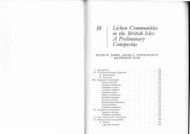Create successful ePaper yourself
Turn your PDF publications into a flip-book with our unique Google optimized e-Paper software.
Simple to sparsely branched. Sp. (13)18-26 x<br />
6.5-10(12) µm Eopyrenula leucoplaca<br />
29* Sp. 2 celled, <strong>of</strong>ten one cell somewhat larger.<br />
Thallus commonly indefinite, without algae or<br />
algae only loosely associated. Per. black.<br />
Paraph. Branched and reticulate<br />
.Mycomicrothelia<br />
30 On silicate rock. Thallus black, finely cracked to<br />
finely areolate. Per. black, flattened<br />
hemispherical protruding, flattened above. Sp.<br />
(2-)4 celled or rarely also with 1-2(4)<br />
longitudinal walls, ± smooth, with perispore, 13-<br />
21 x 6-11 µm Lichenothelia (scopularia)<br />
30* On calcareous rock. Sp. 25-36 x 12-18 µm,<br />
warty, 2 celled, ± egg-shaped. Per. sunken, when<br />
sessile, strongly flattened above. Fungus <strong>of</strong><br />
pyrenocarpic lichens with whitish to gray-reddish<br />
or endolithic thallus Polycoccum marmoratum<br />
(Krempelh.) Hawksw.<br />
31 Sp. with about 20 septa, acicular, at best 50 µm<br />
long. Per. pale yellowish to pale rose or<br />
brownish (very light when moist). Paraph.<br />
Unbranched, permanent. Thallus with<br />
Trentepohlia. In higher sites. Belonia<br />
31* Sp. with much fewer septa, if acicular, then per.<br />
black . 32<br />
32 Per. red-brown to yellow-brown or rose. 33<br />
32* Per. black, at times pruinose and ± gray 35<br />
33 Thallus with coccoid green algae, light greenish,<br />
or light yellowish, or elongated, cylindric to<br />
branched, minute granules, also sometimes<br />
sorediate. Per. light brown to orange-brown, -0.4<br />
mm, with cellular, 30-80 µm thick light exc.,<br />
without paraph. Sp. 4-5(6) celled, 13-21 x 4.5-6<br />
µm. Almost only on elder, maple, or elm<br />
.Macentina stigonemoides<br />
33* Thallus with Trentepohlia, not consisting <strong>of</strong><br />
cylindric to branched light green granules.<br />
Paraph. permanent 34<br />
34 Sp. to 8 per ascus, 4-8 celled, fusiform. Porina<br />
34* Sp. to much more than 8 in (at most 150 µm)<br />
long asci, 4 celled, 12-18 x 5-6 µm. Per. -0.6<br />
mm, pale reddish to brown. Paraph. Simple.<br />
Thallus gray-rose to (in the herbarium) graygreenish<br />
or lighter. Thelopsis (rubella)<br />
35 On rock, soil, or mosses 36<br />
35* On bark . 40<br />
36 Sp. fusiform to narrowly fusiform (to almost<br />
acicular), at best 4 celled. Paraph. Permanent 37<br />
36* Sp. ellipsoidal, 2-4 celled, if fusiform, then 2<br />
celled. Paraph. Permanent or lacking in ripe per<br />
38<br />
37 Per. on white rock-dwelling thallus with green<br />
algae and dispersed soralia (Porpidia<br />
glaucophaea), black, -0.6 mm. Sp. 25-38 x 3-5<br />
µm, mostly 4-5 celled. Paraph. branched.<br />
Parasymbiont. Rare: southern Black Forest and<br />
Vosges Mountains. Sagediopsis barbara<br />
(Th.Fr.) R. Sant. &Triebel (=gongylia<br />
nadvornikii Servit)<br />
37* Thallus without soralia, with Trentepohlia. On<br />
rock, or mosses. Sp. fusiform, 4-8 celled.<br />
Paraph. branched or unbranched . GS Porina<br />
38 With globose green algae in the thallus. Hym. I+<br />
orange to red. Paraph. lacking (but periphyses<br />
occurring in the ostiole region). Per. with or<br />
without involucre. Sp. 2 to rarely 4 celled,<br />
septum usually in the middle. Thelidium<br />
(Verrucaria bryoctona and Pyrenocollema spp.<br />
also commonly have 2 celled sp.)<br />
38* With Trentepohlia or blue-green algae.<br />
Paraph. occurring. Sp. 2 celled 39<br />
39 Sp. with very thick dividing wall, 1 ranked in the<br />
ascus ( s.139), with (<strong>of</strong>ten finely warty)<br />
perispore, with rounded ends, with 2 equal cells.<br />
Per. 0.5-1(1.5) mm. Ascus cylindrical. Paraph.<br />
sparsely branched or bundled. Thallus with<br />
Trentepohlia, <strong>of</strong>ten in the substrate<br />
GS Arthopyrenia: Acrocordia<br />
39* Sp. with the thicker walls and not 1 ranked, with<br />
or without a very thin smooth perispore, usually<br />
2 unequal cells, in species <strong>of</strong> this hemisphere -24<br />
x 7 µm, sometimes even larger. Per. only -0.3<br />
mm, always without an involucre. Hym. I-. Asci<br />
ventricose to almost cylindrical. Paraph. richly<br />
branched and reticulate. With blue-green algae<br />
or Trentepohlia in the thallus (cells yellowish,<br />
orange or blue-green, in P. saxicola yellowish to<br />
orange) GS Arthopyrenia: Pyrenocollema<br />
40 Sp. at times curved or ± spiraled, narrowly<br />
fusiform, acicular, worm-lake, or thread-like, -4<br />
µm wide, 2 to 4 celled. Paraph. branched and<br />
reticulate bound, ± permanent. Per. black, -0.4<br />
mm. Without algae or the algae only loosely<br />
associated. Leptorhaphis<br />
40* Sp. straight, fusiform to ellipsoidal 41<br />
41 Sp. 2 celled, ± ellipsoidal . GS Arthopyrenia<br />
41* Sp. with at least 4 cells . 42<br />
42 Asci clearly thickened above. Paraph. ±<br />
branched, permanent or soon swelling and<br />
scarcely recognizable. Sp. ellipsoidal to<br />
fusiform. Thallus scarcely recognizable or<br />
definite. Without algae or with Trentepohlia .<br />
GS Arthopyrenia<br />
42* Asci thin walled, even the apex scarcely thicker.<br />
Paraph. approaching unbranched, permanent.<br />
Per. 0.2-1 mm. Sp. fusiform, 4-8 celled. Thallus,<br />
as a rule, clearly developed, with Trentepohlia .<br />
. GS Porina<br />
Genus Key VI: Streak and Fleck Fruiting <strong>Lichens</strong><br />
1 Sp. 1 celled, colorless. Thallus with pure green<br />
algae 2<br />
1* Sp. 2 to multicellular, colorless or colored.<br />
Thallus usually with Trentepohlia algae, <strong>of</strong>ten<br />
golden brown to orange yellow at the crevices. . 4<br />
2 On rock. Thallus K+ red. Ap. streaked, with<br />
crack-formed disks. Receptacle black brown<br />
Lithographa tesserata<br />
48





